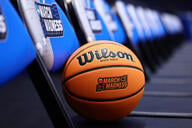You have /5 articles left.
Sign up for a free account or log in.
“Why should we have to go to class if we came here to play FOOTBALL, we ain’t come to play SCHOOL, classes are POINTLESS.”
That was Ohio State University third-string quarterback Cardale Jones’s short-lived message to the world, sent via Twitter last fall. Presumably, somebody in the Buckeye athletics department caught wind of the tweet and ordered its deletion, but not before it was immortalized in screenshots and chastised by commentators. Jones’s Twitter account was closed and he was suspended for a game.
"We allow our student-athletes the opportunity to express themselves via the social mediums," Ohio State said in a statement following the incident. "What we do ask of them and communicate to them is…. always remember not to post or tweet anything that could embarrass themselves, their team, teammates, the university, their family or other groups, organizations or people."
Ohio State’s approach is pretty typical – at least, among those colleges that even bother to train athletes on appropriate social media usage (about half, according to a survey by the College Sports Information Directors). Other strategies include forbidding athletes from using social media at all, or using software to monitor posts and flag anything problematic.
But focusing on the negative clearly only goes so far. That’s why Colgate University officials are actually encouraging their athletes to use social media often, with a focus on what should be said as opposed to what shouldn’t be.
“Saying ‘don’t use it’ is not going to work,” said Matt Hames, manager of media communications at Colgate. “The really scary thing to a lot of people is now a 17-year-old kid has a device in their hand where they can say anything at any time. You just nudge them in a direction where they think about it a different way.”
So instead of tweeting that classes are pointless – a sentiment no doubt shared by myriad students whose social media musings are not put under a microscope – an athlete might highlight his favorite course or professor (or, if there aren’t any, a good play he made that day at practice). Or an interesting thing he would like to learn. Or a career aspiration.
“Essentially, it’s the notion that you have a platform right now,” Hames said, “and people are going to know of you and follow you. So use Twitter, use social media in a positive way. Understand that you have a goal. Think of it that you’re marketing yourself, and your goal is to get noticed by recruiters.”
It’s a message that Kevin DeShazo, who does social media training with Fieldhouse Media and wrote iAthlete: Impacting Student-Athletes of a Digital Generation, has been pushing for years. Ninety-three percent of college athletes use some social media platform every day, he says – colleges need first to acknowledge that, then address it. DeShazo has talked with athletes at about 40 colleges, and those that use monitoring software have seen an average 41 percent drop in offensive or inappropriate content. Measuring value added is harder, but some athletes have e-mailed him to say potential employers lauded their career plan detailed online.
“They’re going to make mistakes and that’s O.K.,” DeShazo said. “That shouldn’t be the end of their life.”
In Hames's presentation this month to Colgate athletes -- the second year he’s done it, the first time with all athletes in one place rather than broken up by team -- Hames leads off with a sometimes-harsh reality: the stated missions of Google, Facebook and Twitter are to share information publicly, openly and instantly. All platforms offer private options -- but their content doesn’t stay private, says a PowerPoint slide featuring a picture of former Rep. Anthony Weiner, whose attempt to recover from the sexting scandal that brought down his career is teetering.
So, set a goal, Hames says, and make everything you tweet, post, Link In or Instagram reflect that goal. Maybe it’s to be drafted by a pro team or recruited by a business, or to secure an internship or promote your image in hopes of nabbing a national media feature. Point is, it’s your brand, and you control it. Colgate has yet to have a major incident, though one or two athletes have talked online about late-night partying. (Colgate also uses the monitoring software IQ Media.)
“As a coach, I have a very negative opinion about some of the social media with student-athletes,” said Nicci Hays Fort, Colgate’s women’s basketball coach, noting the negative publicity it spawns. (Hames said some administrators were reluctant to encourage social media use.) She asked Hames to come present to her team in the spring, and she was enlightened, too. “The whole ‘making a goal’ idea, I think that really hit home…. That’s something I know our student-athletes had not thought of before.”
Now, she said, instead of just Instagramming because everyone else is doing it, her players are doing it to brand themselves, to get hired.
Of course, it’s not just the athletes who stand to gain from this approach. Preventing an unfortunate tweet could save universities and their sports programs a whole lot of time, energy and embarrassment. Texas A&M University quarterback Johnny Manziel’s propensity to photograph and talk about everything he does has tarnished his image and caused more than a few headaches for campus officials. A University of North Carolina at Chapel Hill athlete’s tweet suggesting he was receiving impermissible benefits prompted a National Collegiate Athletic Association investigation and subsequent penalties.
A University of Oregon football player’s tweet suggesting the school shooting in Sandy Hook, Conn., was a government conspiracy prompted a university statement in which officials distanced themselves from the player. And after suspending the athlete for at least one game, the University of Oklahoma football coach Bob Stoops had to apologize for a tweet by a player who mocked the suicide of a student at rival University of Texas.
“Student-athletes are 19- to 24-year-olds; they’re just like every other college student on campus, with one exception. And that’s that they’re under a major spotlight,” said Teresa Valerio Parrot, principal at TVP Communications “For some student-athletes, it may not resonate that what they say reflects positively or negatively on the department, but they’ll probably understand what that impact can be as they look for a job, as they go home at Christmas time and have to face their parents.”
Colgate is taking a realistic approach to an issue most institutions shy away from (and then play catch-up to), despite its potential to cause a publicity crisis, Parrot said. They’re balancing the athletes’ right to be themselves with a mutually desired positive image. It’s a more effective – and more positive – approach than just trying to silence athletes altogether.
“Institutions that say ‘don’t participate’ are missing an opportunity to highlight what student-athletes do,” Parrot said. “You’re not able to hear about them as students.”
The University of Washington, which DeShazo notes as a standout, actually highlights athletes who demonstrate social media savvy on its @UWAthletics Twitter account.
While some excel and others ignore the conundrum, a few have taken it too far: after some universities required athletes to install monitoring software or be booted from the team, 10 states, from California to Delaware, have passed laws forbidding colleges from forcing athletes to provide login information or grant access to online materials that would otherwise be private. Five others have proposed legislation, and a federal bill is on the table, though it hasn't gotten anywhere.




